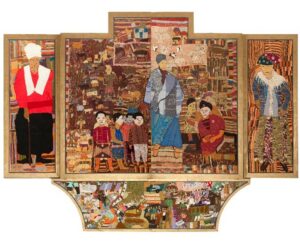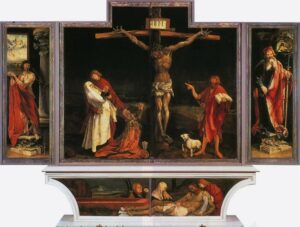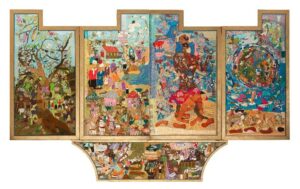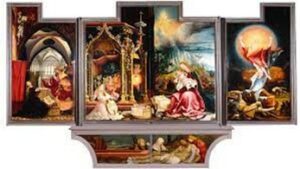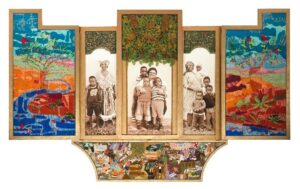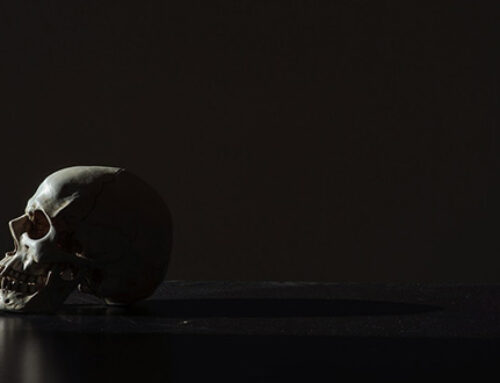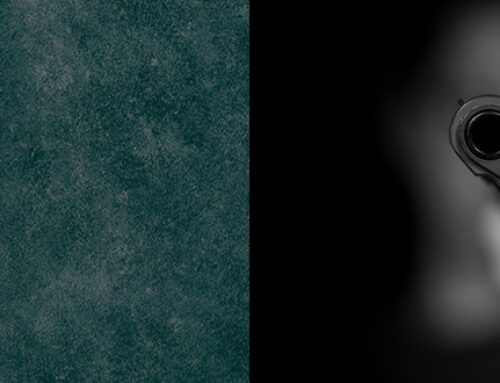I spent countless weekends and holidays in my youth in Hamburg, a quiet rustic village on the southern bank of the Keiskamma River, Eastern Cape, South Africa. Now a grown man with a lovely wife and two adopted African boys, I discover that Hamburg remains much the same after all these years since I last visited it—except for an exquisite piece of tapestry.
We heard that a presentation was being given in the local cultural center about this famous tapestry that was crafted in Hamburg. I had read Karl Barth’s momentous Church Dogmatics not so long ago and knew that he wrote much of it in front of a copy of Matthias Grünewald’s (1470–1528) Isenheim Altarpiece for his theological inspiration. Walking into the gallery in Hamburg I recognize the shape and the colors of the tapestry.
It’s a re-envisioning of the Isenheim Altarpiece with a distinctly Keiskamma feel, artfully weaving together local history, culture, and religious motifs with detailed embroidery. The project was the brainchild of a medical doctor, Carol Hofmeyr, and was crafted by 130 women (and seven men) from the Keiskamma Art Project. It is 4.15 meters high and 6.8 meters wide, as per Grünewald’s altarpiece. But it is the lives of the artists and their stories that make this project come alive and it is to them that tribute is due. The work has traveled the world and has been displayed in various Cathedrals—not surprisingly because it is an impressive project!
The altarpiece is a triptych, which is a paneled art piece that is divided into three sections hinged together so that its leaves can be opened out with three different displays.
The first display with the panels closed has mostly brown colours showing people with little material means searching for purpose. There is a Xhosa widow who mourns the loss of her husband who died from AIDS, together with images of orphaned children whose parents were victims of the virus. The central image is flanked by two of Hamburg’s saints. Both were chosen for their wisdom, and their love for their community. Lagena Mapuma is dressed in her red Methodist church outfit, and Susan Paliso wears a white shawl; you can meet her here. A cross foregrounds this tapestry, reminding us of Jesus’ participation in humanity’s suffering. The cross is empty, providing us a window into the next panel: The Resurrection.
|
|
There we were sitting, listening to the presentation, the panels were flung open in vibrant colour, and my 6-year old son cries out in amazement, “Whoa!” The panels open to a “vision of hope, redemption and restoration.”[1] Lagena Mapuma and Susan Paliso appear again, this time much smaller among images of birds, trees, fish, and all those things that make up an abundant life. The large figure in the second display is a local mystic who runs on the dunes marking his prayers in the sand in art form. You can see him in action here. Traditional life and spiritual worship are woven in harmony with the Christian hope of resurrection and the renewed creation.
|
|
The third and final display of the triptych contains photographs in black and white of children and their grandmothers. As with the original Isenheim Altarpiece where the third display had three-dimensional wood carvings, this piece has three-dimensional wire beadwork of Coral and Acacia trees. I could not help noticing the parallel of the Acacia thorns above the photographs as symbolic of Christ’s atonement as with the very first display in Grünewald’s masterpiece.
|
|
I should mention that the wounds of those diseased in the Keiskamma Altarpiece are depicted similarly to Jesus’s wounds in Grünewald’s work. As the Keiskamma Trust explains, “In the 16th century Matthias Grünewald painted the Issenheim Altarpiece for a hospice in Germany, where the inmates were dying of ergot poisoning. At that time the disease was painful and incurable. Grünewald’s work shows the crucified figure with all the stigmata of the disease…. It depicts the suffering and hopes of a society in the throes of an incurable epidemic.”[2] The Keiskamma Altarpiece draws parallels with contemporary diseases like HIV and AIDS offering hope to the local people of the Keiskamma.
I reflect upon myself as a professional theologian with a PhD focussing on the atonement and African Theology, and those who created this magnificent altarpiece. They too are theologians as much as I am, we stand side by side as brothers and sisters. I do theology in prose grappling with abstract concepts, and they do theology in tapestry telling their stories of Christian faith, suffering and hope in the here and now. We need more of this sort of theologian, grounding theology meaningfully in context, beauty, and the visual arts.
*Much of the information in this blog was adapted from the article, “The Keiskamma Altarpiece” by the Keiskamma Trust. You can read the full article here.
Photographs of the Keiskamma Altarpiece courtesy of Carol Hofmeyr and her son, Robert.
[1]The Keiskamma Trust. 2022. “The Keiskamma Altarpiece.” The Keiskamma Trust, 9 April 2022. http://www.keiskamma.org/art/the-keiskamma-altarpiece/
Short Bio: Dr. Robert Falconer ([email protected]) is the Masters and Doctoral Research Coordinator overseeing all aspects of student research at the M.Th. and Ph.D. level.


